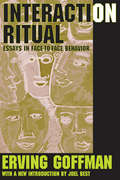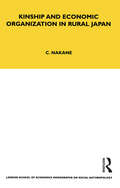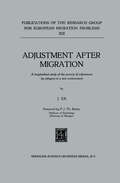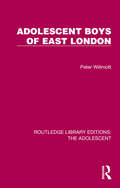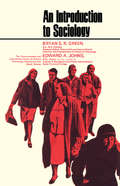- Table View
- List View
Interaction Ritual: Essays in Face-to-Face Behavior
by Erving Goffman"Not then, men and their moments. Rather, moment and their men," writes Erving Goffman in the introduction to his groundbreaking 1967 Interaction Ritual, a study of face-to-face interaction in natural settings, that class of events which occurs during co-presence and by virtue of co-presence. The ultimate behavioral materials are the glances, gestures, positionings, and verbal statements that people continuously feed into situations, whether intended or not.A sociology of occasions is here advocated. Social organization is the central theme, but what is organized is the co-mingling of persons and the temporary interactional enterprises that can arise therefrom. A normatively stabilized structure is at issue, a "social gathering," but this is a shifting entity, necessarily evanescent, created by arrivals and killed by departures. The major section of the book is the essay "Where the Action Is," drawing on Goffman's last major ethnographic project observation of Nevada casinos.Tom Burns says of Goffman's work "The eleven books form a singularly compact body of writing. All his published work was devoted to topics and themes which were closely connected, and the methodology, angles of approach and of course style of writing remained characteristically his own throughout. Interaction Ritual in particular is an interesting account of daily social interaction viewed with a new perspective for the logic of our behavior in such ordinary circumstances as entering a crowded elevator or bus." In his new introduction, Joel Best considers Goffman's work in toto and places Interaction Ritual in that total context as one of Goffman's pivotal works: "His subject matter was unique. In sharp contrast to the natural tendency of many scholars to tackle big, important topics, Goffman was a minimalist, working on a small scale, and concentrating on the most mundane, ordinary social contacts, on everyday life.'"
Kinship and Economic Organisation in Rural Japan (LSE Monographs on Social Anthropology)
by Chie NakaneIn this essay the author presents the principles of one important sector of social organization in Japan, and establish its framework. Japanese kinship structure, with its multiple historical and local factors, and unlike that of the Chinese or of the Hindus, does not belong to the category of unilineal systems, nor to any kind of descent pattern found in the published literature of social anthropology. Social anthropology, developed by micro-synchronic studies of simpler societies, and with its major analysis devoted to descent systems, has to face in Japan a critical methodological test. In this essay, the author, as a social anthropologist, want to overcome these drawbacks of anthropological method, and to demonstrate one of the new approaches by which an anthropologist can cope with the data from a sophisticated society
Kinship and Economic Organisation in Rural Japan (LSE Monographs on Social Anthropology)
by Chie NakaneIn this essay the author presents the principles of one important sector of social organization in Japan, and establish its framework. Japanese kinship structure, with its multiple historical and local factors, and unlike that of the Chinese or of the Hindus, does not belong to the category of unilineal systems, nor to any kind of descent pattern found in the published literature of social anthropology. Social anthropology, developed by micro-synchronic studies of simpler societies, and with its major analysis devoted to descent systems, has to face in Japan a critical methodological test. In this essay, the author, as a social anthropologist, want to overcome these drawbacks of anthropological method, and to demonstrate one of the new approaches by which an anthropologist can cope with the data from a sophisticated society
On Aggression (Routledge Classics Ser.)
by Konrad LorenzFirst published in the 1960s, On Aggression has been the target of criticism and controversy ever since. It is not Lorenz's careful descriptions of animal behaviour that are contentious, but his extrapolations to the human world that have caused reverberations resulting in a statement adopted by UNESCO in 1989 and subsequently endorsed by the American Psychological Association that appears to condemn his work. But does On Aggression actually make the claims implicit in the Seville statement?In a new introduction by Professor Eric Salzen, the debate about Lorenz's work is set in its social and political context and his claims and those of his critics reassessed. Human aggression has not lessened since this seminal work first appeared and there are no convincing new solutions. On Aggression should be read by all new students and re-read by more experienced scholars so that the important evidence he presents from ethnology may be reappraised in the light of the most recent research.
On Aggression
by Konrad LorenzFirst published in the 1960s, On Aggression has been the target of criticism and controversy ever since. It is not Lorenz's careful descriptions of animal behaviour that are contentious, but his extrapolations to the human world that have caused reverberations resulting in a statement adopted by UNESCO in 1989 and subsequently endorsed by the American Psychological Association that appears to condemn his work. But does On Aggression actually make the claims implicit in the Seville statement?In a new introduction by Professor Eric Salzen, the debate about Lorenz's work is set in its social and political context and his claims and those of his critics reassessed. Human aggression has not lessened since this seminal work first appeared and there are no convincing new solutions. On Aggression should be read by all new students and re-read by more experienced scholars so that the important evidence he presents from ethnology may be reappraised in the light of the most recent research.
The Order of Minims in Seventeenth-Century France (International Archives of the History of Ideas Archives internationales d'histoire des idées #20)
by P.J.S. WhitmorePatterns of Care for the Subnormal: The Commonwealth and International Library: Mental Health and Social Medicine Division
by Michael Craft Lewis MilesPatterns of Care for the Subnormal examines the pattern of care for the mentally subnormal in relation to medical, educational, and social services in England and Wales. Topics covered range from variations on the theme of subnormality to the prevalence of mental subnormality, hospital functions, and trends in hospital and community services. A comprehensive service for the subnormal is also considered.Comprised of 10 chapters, this book begins with an analysis of the term subnormal from the educational, legal, sociological, psychological, and administrative perspectives. The discussion then turns to variations on the theme of subnormality by presenting four case histories to illustrate the usage of the term subnormality. Subsequent chapters focus on the prevalence of mental subnormality; trends in a hospital service and in a community service; subnormality admissions to Welsh subnormality hospitals in 1964; and patients needing all types of subnormality hospital care in Wales in 1965. Patterns of subnormality care in other societies are also considered. The final chapter describes a comprehensive service for the subnormal that encompasses prevention and diagnosis as well as education and training, community social services, and full-time care. This monograph will be of interest to doctors, psychologists, educationalists, and administrators.
Promise Me You'll Shoot Yourself: The Downfall of Ordinary Germans, 1945
by Florian HuberThe extraordinary German bestseller on the final days of the Third ReichOne of the last untold stories of the Third Reich is that of the extraordinary wave of suicides, carried out not just by much of the Nazi leadership, but by thousands of ordinary Germans, in the war's closing period. Some of these were provoked by straightforward terror in the face of advancing Soviet troops or by personal guilt, but many could not be explained in such relatively straightforward terms. Florian Huber's remarkable book, a bestseller in Germany, confronts this terrible phenomenon. Other countries have suffered defeat, but not responded in the same way. What drove whole families, who in many cases had already withstood years of deprivation, aerial bombing and deaths in battle, to do this? In a brilliantly written, thoughtful and original work, Huber sees the entire project of the Third Reich as a sequence of almost overwhelming emotions and scenes for many Germans. He describes some of the key events which shaped the period from the First World War to the end of the Second, showing how the sheer intensity, allure and ferocity of Hitler's regime swept along millions. Its sudden end was, for many of them, simply impossible to absorb.
Psychologie der Sprache
by Hans HörmannIm deutschen Sprachgebiet ist vor dreißig Jahren ein Werk der Sprachpsychologie erschienen, welchem klassische Gültigkeit gebührt: Kar! B ÜHLERS " Sprachtheorie" . Die politischen Ereignisse haben dieses Werk um seine volle Wirkung gebracht. Die Psychologie in Deutschland wandte sich insgesamt wieder von der empiristischen Grundhaltung ab, welche - von FECHNER und WUNDT bis zur Gestaltpsychologie - der Motor ihrer großen Lei stungen gewesen war. Auf diese Weise wurde die Sprachpsychologie bei uns in starkem Maße rein geisteswissenschaftlich orientiert. Das konnte um so leichter geschehen, als das geheimnisvolle Phä nomen der Sprache zur Mystifikation und zur Verwendung eines Prestige induzierenden Stils geradezu herausfordert. Was in deutscher Sprache beispielsweise über das Problem der Bedeutung geschrieben wurde, ist weithin durch die Tatsache geprägt, daß "bedeutend" einen positiven Wert, eine Anerkennung impliziert ("ein bedeutender Mensch"). Die Auswirkung dieser merkwürdigen Synonymie auf Philosophie, Anthropo logie und Psychologie ist ein amüsantes Exempel der Richtigkeit WHoRFscher Thesen. Die Möglichkeit, in der Sprache über die Sprache spekulieren zu können, ist der Entwicklung der Sprachpsychologie nicht günstig gewesen. Aus der allgemeinen Stagnation hebt sich lediglich das monumentale Werk von KAINZ heraus, das 1940 zu erscheinen be gann, jetzt beim ersten Halbband des 5. Bandes angelangt ist und mit der Akribie eines Handbuchs sozusagen die abschließende Summe der BÜHLERSehen Epoche der Sprachpsychologie zieht.
Time of One's Own: Leisure and Young People (Selected Works of Pearl Jephcott: Social Issues and Social Research)
by Pearl JephcottOriginally published in 1967, Time of One’s Own asks the question: How do young Scots spend their free time nowadays? The Kilbrandon Council asked the University of Glasgow to undertake a study on this subject and their conclusions form the subject of this book. ‘Young Scots’ were confined to those aged fifteen to nineteen, and in the main to those living in three localities which it was hoped were reasonably typical – a mining town in West Lothian and, in Glasgow, an old inner area and a new outlying housing estate. Some three thousand boys and girls provided facts and views. In addition to statistical material the study constantly refers to the ‘how and why’ of the way in which the individual youngster spent their free time. The adults who collected the information agreed that what they saw of the leisure of these adolescents lacked variety and sparkle. On the other hand, a considerable proportion of the boys and girls appeared to be on the brink of using it in less stereotyped ways. Just a little push might have done the trick. In general, the provision for recreation was inadequate. This was especially so in the case of indoor facilities. The Youth Service, which should play so important a role, required far more support. This is a valuable record from the time of what it was like to have ‘Time of One’s Own’, and this reissue is a fascinating addition to all those interested in the history of Education and Sociology.
Time of One's Own: Leisure and Young People (Selected Works of Pearl Jephcott: Social Issues and Social Research)
by Pearl JephcottOriginally published in 1967, Time of One’s Own asks the question: How do young Scots spend their free time nowadays? The Kilbrandon Council asked the University of Glasgow to undertake a study on this subject and their conclusions form the subject of this book. ‘Young Scots’ were confined to those aged fifteen to nineteen, and in the main to those living in three localities which it was hoped were reasonably typical – a mining town in West Lothian and, in Glasgow, an old inner area and a new outlying housing estate. Some three thousand boys and girls provided facts and views. In addition to statistical material the study constantly refers to the ‘how and why’ of the way in which the individual youngster spent their free time. The adults who collected the information agreed that what they saw of the leisure of these adolescents lacked variety and sparkle. On the other hand, a considerable proportion of the boys and girls appeared to be on the brink of using it in less stereotyped ways. Just a little push might have done the trick. In general, the provision for recreation was inadequate. This was especially so in the case of indoor facilities. The Youth Service, which should play so important a role, required far more support. This is a valuable record from the time of what it was like to have ‘Time of One’s Own’, and this reissue is a fascinating addition to all those interested in the history of Education and Sociology.
Adjustment after Migration: A longitudinal study of the process of adjustment by refugees to a new environment
by J. ExPeople are not so firmly rooted as they used to be. The greater frequency, at least in the Western world, with which people move house can be seen from the statistics. Many migrate voluntarily, or under compulsion, to build up new existences in other parts of the country or in other parts of the world. The problems which face people who are obliged to settle elsewhere have become matters of national and international political importance. Of recent years they have also become the subjects of sociological and socio-psychological research. The psychological research of which this book gives an account took place among families who some years ago emigrated from what was then known as the Dutch East Indies to the Netherlands. Dutch is the language spoken from their youth. Born and bred in another part of the world they embarked in groups to the Nether lands, which they had never seen before, when the country they lived in became independent. No doubt they had a vivid image of the Netherlands. It was the Mother country; they had heard a great deal about it in the course of the simple education they had received. They were acquainted with it through pictures and through the contact, however superficial, with representatives of the ruling country. The military service which had played such an important part in the lives of the male adults had made them feel bound up with the country of the House of Orange.
Adolescent Boys of East London (Routledge Library Editions: The Adolescent)
by Peter WillmottOriginally published in 1966, this is a sociological study of boys growing up in East London. Previous books from the Institute of Community Studies had looked at the lives of other residents of Bethnal Green – couples with young children, middle-aged ‘Mums’, old people, widows. Now the subject is adolescent boys – a study of them not in isolation nor primarily as a ‘problem’ group but as young people moving between childhood and adulthood in the setting of a particular local community. What is it like to grow up in a district like Bethnal Green? How do the boys adjust to the process? What part is played by school, work, youth club, family? What are the boys’ relationships with their fellows and with girls? Where does delinquency fit in? To help answer such questions, a sample of 246 boys aged 14 to 20 were interviewed. The statistical analysis of this survey has been supplemented by illustrative material from diaries, tape-recorded interviews, and informal observation. The outcome is a vivid account, much of it in the boys’ own words, which was rather different from some popular views of contemporary adolescence at the time. Today it can be read and enjoyed in its historical context.
Adolescent Boys of East London (Routledge Library Editions: The Adolescent)
by Peter WillmottOriginally published in 1966, this is a sociological study of boys growing up in East London. Previous books from the Institute of Community Studies had looked at the lives of other residents of Bethnal Green – couples with young children, middle-aged ‘Mums’, old people, widows. Now the subject is adolescent boys – a study of them not in isolation nor primarily as a ‘problem’ group but as young people moving between childhood and adulthood in the setting of a particular local community. What is it like to grow up in a district like Bethnal Green? How do the boys adjust to the process? What part is played by school, work, youth club, family? What are the boys’ relationships with their fellows and with girls? Where does delinquency fit in? To help answer such questions, a sample of 246 boys aged 14 to 20 were interviewed. The statistical analysis of this survey has been supplemented by illustrative material from diaries, tape-recorded interviews, and informal observation. The outcome is a vivid account, much of it in the boys’ own words, which was rather different from some popular views of contemporary adolescence at the time. Today it can be read and enjoyed in its historical context.
Conflict Resolution and World Education (World Academy of Art and Science)
by Stuart Mudd World Academy of Art and ScienceEmotionally Disturbed Children: Proceedings of the Annual Study Conference of the Association of Workers for Maladjusted Children, Edinburgh, August 1965
by S. M. MaxwellEmotionally Disturbed Children is a collection of papers presented at the Proceedings of the Annual Study Conference of the Association of Workers for Maladjusted Children held in Edinburgh in August 1965. This collection of papers studies the different approaches in dealing with the problems of maladjustment in school children. This book describes the different maladjustment problems found in Scotland, in Sweden, and in the Scandinavian countries. For example, a paper discusses the educational system in Sweden, in Norway, and in Denmark. This book also examines the differences in problems, conditions, and methods of treatment used in these countries. This text discusses the readiness of pupils to attend schools; the methods developed in the education of maladjusted children; and the regulations that are prescribed to deal with disciplinary measures. This book then enumerates the kinds of disciplinary problems found in Scandinavian schools as focusing on increased group activity and on the new Education Act. The philosophy of a pupil-centered establishment points to the rise of student welfare and institutions such as the Child Guidance Clinics and the Child Welfare organization. This book then discusses the concept of prevention as a primary element in the somatic field of child care in Denmark and the day care approach in addressing emotional disturbed children in Glasgow. This compendium is suitable for child psychiatrists, school administrators, guidance counselors, psychologists, and education ministry officials.
Housing and Local Government: In England and Wales
by J. B. CullingworthOriginally published in 1966 and written at a time when UK housing policy was undergoing major changes, this volume provides a substantial historical introduction which outlines the development of housing policy in the UK from the mid 19th – mid 20th Centuries. Discussion of the administrative framework, the powers of local housing authorities, housing standards, finance and the improvement of older housing follows. Other issues covered include the social aspects of housing and the role of the state and the objectives of state action.
Housing and Local Government: In England and Wales
by J. B. CullingworthOriginally published in 1966 and written at a time when UK housing policy was undergoing major changes, this volume provides a substantial historical introduction which outlines the development of housing policy in the UK from the mid 19th – mid 20th Centuries. Discussion of the administrative framework, the powers of local housing authorities, housing standards, finance and the improvement of older housing follows. Other issues covered include the social aspects of housing and the role of the state and the objectives of state action.
Institutional Neurosis
by Russell BartonInstitutional Neurosis is a four-chapter text that systematically presents the dreadful mental changes that may result from institutional life and the steps that can be taken to cure them. The term “institutional neurosis" promotes the syndrome to the category of a disease, rather than a process, thereby encouraging the public to understand, approach, and deal with it in the same way as other diseases. The opening chapter describes the clinical features of the disorder in mental hospitals, its differential diagnosis, etiology, treatment, and prevention. The next chapters consider the etiology or factors associated with institutional neurosis, including apathy, loss of interest, lack of initiative, and sometimes a characteristic posture and gait. The last chapter reviews the various aspects of the treatment of institutional neurosis. This book is of value to neurologists, psychologists, psychiatrists, and researchers in the allied fields.
An Introduction to Sociology
by Bryan S. Green Edward A. JohnsAn Introduction to Sociology presents the theoretical approaches, the methods of inquiry, and the concepts with which sociologists attempt to order the intricate phenomena of social interaction. This book provides an illustration of particular investigations that may provide some insights into substantive features of society and social behavior. Organized into six chapters, this book starts with an overview of scientific proposition, which is the statement of a relationship between specified properties of events and objects. This text then explains the fundamental concepts that appear in the empirical and theoretical writings of sociologists. Other chapters present a discussion of what sociologists actually study, which includes the substantive areas of investigation and the aims of the investigation. This book discusses as well the institutionalized areas of society, including the family, the economy, and the polity. The final chapter deals with the theories of the middle-range. This book is a valuable resource for sociologists.
